- Joined
- Feb 26, 2009
- Messages
- 277,087
- Reaction score
- 8
I am pleased to be among thousands of like-minded fishermen who continue to recognise the old pike season. It could be said that pike fishing takes a back seat in the warmer months purely because there are so many other species to occupy our minds; or that pike anglers don’t want the hassle of keeping sea-baits cold and fresh during summer trips. I just like to think we see pike fishing as a winter pursuit…something new and different to do once the warm, balmy mornings make way for those finger-numbing starts in the half-dark of a winter’s morn – it keeps it special, and it’s always been my understanding rather than my experience (for I have caught plenty of summer pike in years gone by) that the species doesn’t fare too well when caught in the warmer months. In any case, pike are not a particularly resilient species so a lay-off can be no bad thing.
Whatever the reason, our abstinence preserves the excitement we feel each October as we bring out the pike rods, load-up the reels with fresh 15lb line and spend a couple of evenings on the settee making traces. As twee or piscatorially romantic as that may sound, I confess to becoming thoroughly ******-off after the third or even the second new trace has been coiled and placed in my tackle-box. It’s a job that has to be done but I think we could make things easier for ourselves by going over to single-hook traces for at least some of our fishing and, to be very honest, I wouldn’t shed too many tears if single hooks were made mandatory for piking. I’ve caught what seems like a huge number of pike over the years so, factually, there’s not much or anything I can be told about the value of a correctly-timed strike: I’ve seen it all – and while a pair of trebles around the scissor area of a pike’s jaw presents no problem visually or practically, those same hooks present an appalling prospect when they’re ‘out of sight’, shall we say? Even the most experienced of pike anglers will struggle – and probably fail – to remove such hooks without badly damaging or even killing the very thing that’s given him and the world so much pleasure. It’s happened to me and, I tell you honestly, I felt bad for weeks on end (still do) and I determined at that time to pike-fish exclusively with singles.
My very next trip saw me get a run on a tail-hooked 7” trout and, it must be said, the thought of my recent experience caused me to strike too soon and I failed to hook what was, without question, a big fish. Had I ‘given it longer’ I feel sure I’d have hooked it perfectly BUT if I hadn’t… a deep-hooked single should not have presented as big a problem for me or – more importantly – the pike.
If your bait is armed with two trebles as shown below, the strike should be made more or less immediately after bite-detection. IF the strike fails to set the hooks and the pike comes off, I believe we should take a philosophical line and wish the fish well, rather than ‘give it longer’ next time.
I have returned to fishing 2 x treble rigs on occasions and they remain probably the most widely used rig for pike fishing with bait. May as well get it right then!
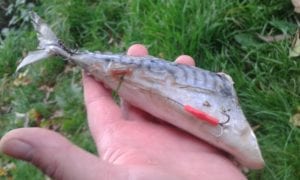
Here’s the standard trace I use: 20-25lb wire, size 6 ‘Prowla’ trebles when possible, and good quality swivels such as Berkley or Mustad, but there is a good variety of good, strong swivels available today. Always choose a reputable make.
Making the trace pictured above is something of an art but it’s soon mastered.
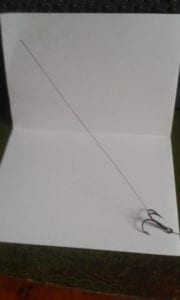
The ‘upper’ hook goes on first. Use 24-30”*of multi-strand wire.
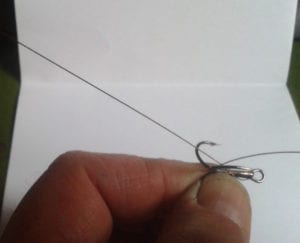
The long end is folded over the join and pulled back taut.
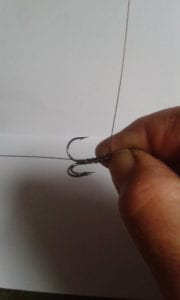
The shank is wrapped 6-7 times by the long end*which is then put through the eye.
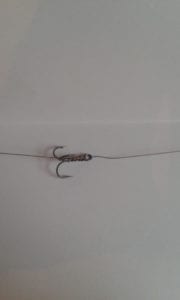
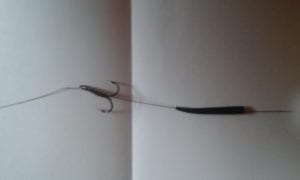
Slide rubber sleeve onto short end narrow end first.
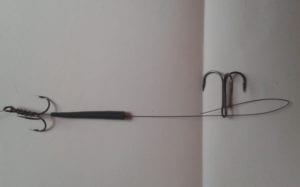
Push loop through eye of lower hook, take it over all 3 bends and pull tight onto the eye with forceps.
*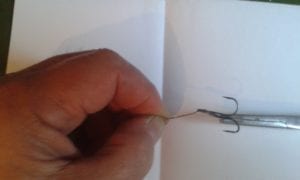
Clamp forceps to hook-bend and repeatedly twist while*pinching wire together with forefinger and thumbnail.
*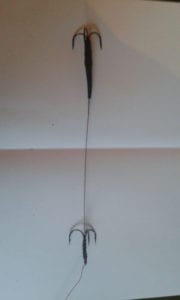
The finished product. Just add swivel*and a sleeve using loop method shown in (6)
Clearly, each set of trebles is fixed and there is a school of thought that insists that the upper set is allowed to slide, not only to facilitate baits of differing sizes but to improve the chance of a good hook-up. This may at first seem counter-intuitive because the top treble slides, but the notion has merit: can both trebles penetrate simultaneously? Might the presence of a second treble actually hinder the efficacy of the other? If, say, the top treble is in the act of penetrating, can the lower treble be following suit? This question is worthy of consideration but beyond the scope of this short article. Suffice to say that it’s a fair argument for using just one treble.
Whatever your preference here, do avoid the folly and disappointment of having the line above your rig bitten-through. Paternoster-fishing with live-bait and with dead-bait – particularly in rivers – can easily see the trace become entangled with the main line. Use a wire up-trace equal or greater in length to the hook trace to prevent bite-offs! These can and do happen when such a precaution has not been taken.

Making a single hook trace is, then, straightforward. Without a detailed record of pike I’ve caught on singles, I gravitate toward those long-shanked, forged, beaked, Kirby-bend sea-hooks in sizes 2 and 1 but any forged hook of good pedigree will suffice. Whether to opt for barbless is down to personal choice: I stick with barbed or semi-barbed.
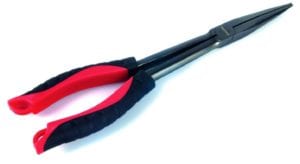
Long, locking forceps with foam-lined finger pieces and long-nosed pliers have been in my tackle bag for donkey’s years but I have added a pair of Prowla wire-cutters more recently. So far it has not been necessary to use them but the need to snip through one or more hooks is always a possibility. Be prepared. Having caught a pike we have a huge responsibility to return it in the best possible condition.

The great majority of pike captures can be dealt with using nothing more than locking forceps like those below. Even hooks located at the rear of the pike’s mouth can be clamped and turned by carefully going in through the gill cover. Seasoned pikers will know the jaw-holding technique and possess the confidence to tackle most unhooking jobs. Anglers new to pike fishing (even life-long ‘coarse’ anglers) are seriously advised to gain piking / unhooking experience with someone who knows the ropes. Don’t even consider lobbing out a pike bait – or a spinner – if you’re not properly tooled up. I have actually returned a hundred miles home because I’d forgotten to pack my tool-kit.
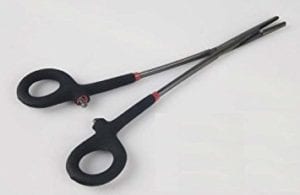
Quick tip: When single-hook fishing with sprats (which are soft): hook once through the tail-root, turn it and hook-through again for a better purchase when casting – but use a large hook.
Cliff Hatton
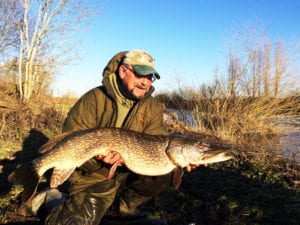
A nice river fish of 25lbs bang-on, Jan. 2018.
Source Article...
Whatever the reason, our abstinence preserves the excitement we feel each October as we bring out the pike rods, load-up the reels with fresh 15lb line and spend a couple of evenings on the settee making traces. As twee or piscatorially romantic as that may sound, I confess to becoming thoroughly ******-off after the third or even the second new trace has been coiled and placed in my tackle-box. It’s a job that has to be done but I think we could make things easier for ourselves by going over to single-hook traces for at least some of our fishing and, to be very honest, I wouldn’t shed too many tears if single hooks were made mandatory for piking. I’ve caught what seems like a huge number of pike over the years so, factually, there’s not much or anything I can be told about the value of a correctly-timed strike: I’ve seen it all – and while a pair of trebles around the scissor area of a pike’s jaw presents no problem visually or practically, those same hooks present an appalling prospect when they’re ‘out of sight’, shall we say? Even the most experienced of pike anglers will struggle – and probably fail – to remove such hooks without badly damaging or even killing the very thing that’s given him and the world so much pleasure. It’s happened to me and, I tell you honestly, I felt bad for weeks on end (still do) and I determined at that time to pike-fish exclusively with singles.
My very next trip saw me get a run on a tail-hooked 7” trout and, it must be said, the thought of my recent experience caused me to strike too soon and I failed to hook what was, without question, a big fish. Had I ‘given it longer’ I feel sure I’d have hooked it perfectly BUT if I hadn’t… a deep-hooked single should not have presented as big a problem for me or – more importantly – the pike.
If your bait is armed with two trebles as shown below, the strike should be made more or less immediately after bite-detection. IF the strike fails to set the hooks and the pike comes off, I believe we should take a philosophical line and wish the fish well, rather than ‘give it longer’ next time.
I have returned to fishing 2 x treble rigs on occasions and they remain probably the most widely used rig for pike fishing with bait. May as well get it right then!

Here’s the standard trace I use: 20-25lb wire, size 6 ‘Prowla’ trebles when possible, and good quality swivels such as Berkley or Mustad, but there is a good variety of good, strong swivels available today. Always choose a reputable make.
Making the trace pictured above is something of an art but it’s soon mastered.

The ‘upper’ hook goes on first. Use 24-30”*of multi-strand wire.

The long end is folded over the join and pulled back taut.

The shank is wrapped 6-7 times by the long end*which is then put through the eye.


Slide rubber sleeve onto short end narrow end first.

Push loop through eye of lower hook, take it over all 3 bends and pull tight onto the eye with forceps.
*

Clamp forceps to hook-bend and repeatedly twist while*pinching wire together with forefinger and thumbnail.
*

The finished product. Just add swivel*and a sleeve using loop method shown in (6)
Clearly, each set of trebles is fixed and there is a school of thought that insists that the upper set is allowed to slide, not only to facilitate baits of differing sizes but to improve the chance of a good hook-up. This may at first seem counter-intuitive because the top treble slides, but the notion has merit: can both trebles penetrate simultaneously? Might the presence of a second treble actually hinder the efficacy of the other? If, say, the top treble is in the act of penetrating, can the lower treble be following suit? This question is worthy of consideration but beyond the scope of this short article. Suffice to say that it’s a fair argument for using just one treble.
Whatever your preference here, do avoid the folly and disappointment of having the line above your rig bitten-through. Paternoster-fishing with live-bait and with dead-bait – particularly in rivers – can easily see the trace become entangled with the main line. Use a wire up-trace equal or greater in length to the hook trace to prevent bite-offs! These can and do happen when such a precaution has not been taken.

Making a single hook trace is, then, straightforward. Without a detailed record of pike I’ve caught on singles, I gravitate toward those long-shanked, forged, beaked, Kirby-bend sea-hooks in sizes 2 and 1 but any forged hook of good pedigree will suffice. Whether to opt for barbless is down to personal choice: I stick with barbed or semi-barbed.

Long, locking forceps with foam-lined finger pieces and long-nosed pliers have been in my tackle bag for donkey’s years but I have added a pair of Prowla wire-cutters more recently. So far it has not been necessary to use them but the need to snip through one or more hooks is always a possibility. Be prepared. Having caught a pike we have a huge responsibility to return it in the best possible condition.

The great majority of pike captures can be dealt with using nothing more than locking forceps like those below. Even hooks located at the rear of the pike’s mouth can be clamped and turned by carefully going in through the gill cover. Seasoned pikers will know the jaw-holding technique and possess the confidence to tackle most unhooking jobs. Anglers new to pike fishing (even life-long ‘coarse’ anglers) are seriously advised to gain piking / unhooking experience with someone who knows the ropes. Don’t even consider lobbing out a pike bait – or a spinner – if you’re not properly tooled up. I have actually returned a hundred miles home because I’d forgotten to pack my tool-kit.

Quick tip: When single-hook fishing with sprats (which are soft): hook once through the tail-root, turn it and hook-through again for a better purchase when casting – but use a large hook.
Cliff Hatton

A nice river fish of 25lbs bang-on, Jan. 2018.
Source Article...
